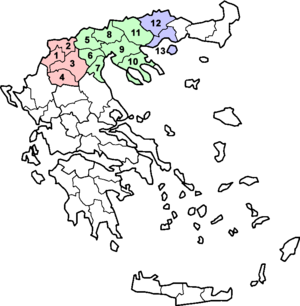Maqedonia e Egjeut


Maqedonia e Jugut apo Maqedonia e Egjeut (maqedonisht: Егејска Македонија/Egejska Makedonija) ose Maqedonia (greqisht: Μακεδονία/Makedonia, maq: Македонија/Makedonija) është një rajon administrativ dhe gjeografik sot në Greqi. Kjo pjesë e Maqedonisë mbulon 52 % territorit historiko-gjeografik të Maqedonisë.
Ndarjet politike
[Redakto | Redakto nëpërmjet kodit]Maqedonia është e ndarë në tri rajone të cilat quhen periferi. Peria është ndarë në 13 njësi të vogla administrative të quajtur Prefektura, e ato janë :
Historia
[Redakto | Redakto nëpërmjet kodit]Gjeografia
[Redakto | Redakto nëpërmjet kodit]Maqedonia është rajon në jug të gadishullit ballkanik. Në Greqi, ka një sipërfaqe 34 177 km². Kryeqytet i Maqedonisë është Selaniku. Disa nga ishujt janë: Taso, Samotrakë, Amulan, etj.
Demografia
[Redakto | Redakto nëpërmjet kodit]Në Maqedoninë jetojnë rreth 2,6 milionë banorë. 98 % janë Maqedonas me pjesën e madhe të ardhur nga Anadolli pas shkëmbimin e popullsive greko-turke në vitin 1923.[2] Në Maqedoni të jugut edhe jetojnë autokton Maqedonas që flasin gjuhën Maqedonisht të sllavishtjes por shumica janë të asimiluar me forcë nga qeveria grek.[3][4][5][6] Popullsia maqedonase etnike numëron 100.000 njerëz, por shumica identifikohen si "grekët" dhe shumë prej tyre janë nacionalistët grekë.[4] Nga kjo popullatë vetëm 10.000-20.000 njerëz e shohin veten si maqedonas etnikë.[4][3] Feja dominuese në Maqedoni është feja ortodokse. Pothuajse gjithë popullsia flet gjuhën greke.
Burimet
[Redakto | Redakto nëpërmjet kodit]- ^ Danforth, Loring M. The Macedonian conflict: Ethnic nationalism in a transnational world, Princeton University Press, 1997, f. 164. "By the late 1980s, when the dispute over Macedonian identity was growing increasingly fierce, both Greek and Macedonian nationalists, particularly those in the diaspora, eagerly seized on the sun or star of Vergina as a powerful national symbol that expressed their competing claims to continuity with the ancient Macedonians."
- ^ Livanios, Dimitris (2008). The Macedonian Question: Britain and the Southern Balkans 1939-1949. Oxford University Press. f. 24-25. "As far as Greek Macedonia is concerned, the exchange of populations between Bulgaria and Greece (‘voluntary’, 1919 onwards) and between Turkey and Greece (compulsory, 1923 onwards), provided for by the Treaties of Neuilly and Lausanne respectively, dramatically altered the ethnographic picture of that area. More than 600,000 Greek refugees were settled in Macedonia, mainly in its eastern part, while over 50,000 Slavs left Greece. Before 1923, the Greeks were a minority in their own northern province, but after the coming of the refugees the Hellenization of Greek Macedonia became reality. According to the Greek census of 1928, there were about 80,000 Slav-speakers in northern Greece, which is undoubtedly a gross underestimate, for Greek archival sources give a much higher number: about 200,000. According to the same sources, however, the majority were just peasants. while the ‘Bulgarians’, that is those who displayed a Bulgarian national consciousness, were about 80,000. Despite the Slav exodus from Greek Macedonia, a by-product of population exchanges, fear, and oppression on the part of the Greek state, solid Slav enclaves remained in the Greek province, and particularly in the districts of Florina, and Kastoria, in Greek west Macedonia."
- ^ a b Murati, Shaban (2019), "Greqisë po i çahet thesi i minoriteteve", Bota Sot, Vizituar 2 mars 2019.
- ^ a b c Margaronis, Maria. (2019), "Greece's invisible minority - the Macedonian Slavs". BBC. Vizituar 24 shkurt 2019. "Historian Leonidas Embiricos estimates that more than 100,000 still live in the Greek region of Macedonia, though only 10,000 to 20,000 would identify openly as members of a minority - and many others are proud Greek nationalists."
- ^ Jakov Marusic, Sinisa, (2019), "Athens Slams BBC over ‘Greece’s Macedonian Minority’ Report", Balkaninsight, Vizituar 2 mars 2019.
- ^ Karatsareas, Petros. (2018), "Greece's Macedonian Slavic heritage was wiped out by linguistic oppression – here's how". The Conversation. Vizituar 19 prill 2018.
